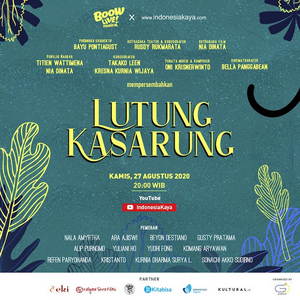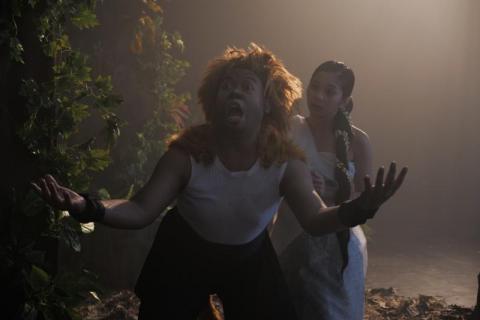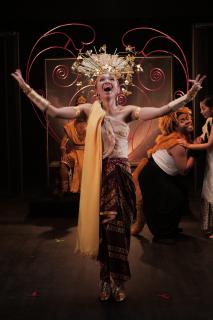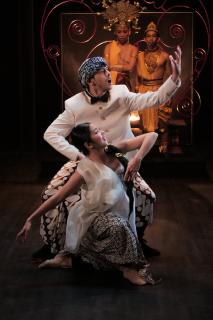Review: #MusikalDiRumahAja Finished Strong with LUTUNG KASARUNG's Radiant Energy
A perfect ending for a new frontier of Indonesian musical theatre.
 The sixth and final offering from #MusikalDiRumahAja closes the 6-episode web series on a high note. The Sundanese folktale of Lutung Kasarung was a joy to watch from start to finish, owing to the immaculate cinematography and fun theatricality.
The sixth and final offering from #MusikalDiRumahAja closes the 6-episode web series on a high note. The Sundanese folktale of Lutung Kasarung was a joy to watch from start to finish, owing to the immaculate cinematography and fun theatricality.
As usual, the BOOW! Live and indonesiakaya.com's collaborative web musical can be watched on the latter's YouTube channel for one week, from August 27th through September 3rd. The episode was led by Nia Dinata as the cinematic director and Rusdy Rukmarata as the theatrical director and featuring story and lyrics by Titien Wattimena and Nia Dinata, music by Oni Krisnerwinto, as well as choreography by Kresna Kurnia Wijaya, Rusdy Rukmarata, and Takako Leen.
Although the original folktale is slightly longer, the episode once again truncated most of the backstory. #MusikalDiRumahAja's Lutung Kasarung opened with the exiled princess Purbasari (Nala Amrytha) walking in the forest, reminiscing of her past.

Her older sister, Purbararang (Ara Ajisiwi) had schemed to put a curse of ugliness on Purbasari in order to claim the throne for herself. Disgraced, Purbararang was exiled and lived with Lutung Kasarung (Beyon Destiano), a talking monkey and leader of the forest's monkey tribe.
Fortuitously, Purbasari had found a magical fountain that dispelled the curse. Now with her beauty restored, the threat of Purbasari returning to claim her rightful place pushed Purbararang to enact one final gambit.
She challenged Purbasari to come to the capital to decide whose bethrotred was more worthy to be crowned king. Seeing that Purbasari had brought Lutung, a monkey, as her beloved, she and Indrajaya (Alip Purnomo) laughed at the sight. Her victory was short-lived, however, as Lutung returned to his original form: the handsome and noble Guruminda (Gusty Pratama). Purbasari returned to the throne and led the kingdom to prosperity alongside Guruminda.

Among the six episodes in the series, Lutung Kasarung was a great choice as the closer. It was a thoroughly enjoyable watch while still keeping a more traditional interpretation of the story it was based on; yet, the songs, cinematography, pacing, and tone of the work all felt contemporary and hip.
The episode managed to cram in all the backstory without feeling too stuffy (although some dialogues were too blatantly expository). What we saw on screen flowed well, because everything relevant on the narrative timeline set by the episode was shown and not just told, something many of the other episodes lacked.
Furthermore, the songs were both varied and effective. No song ran too long. And composer Oni Krisnerwinto had seemingly drawn from disparate sources such as jazz, traditional Indonesian music, and hip hop, while keeping them coherent and pleasant.

Music was also an effective tool to differentiate the characters. The boisterous and energetic Lutung and his troupe of monkeys (played with great charm by EKI Dance Company) had upbeat tunes to dance to; the 'classic princess' Purbasari and her beau Guruminda got Disney-ish romantic ballads; and catchy patter songs were given to the villainous-but-fun Purbararang, making her a character you love to hate and hate to love.
Of course, the direction couldn't have been executed without a solid performance by the cast as well. Every actor did well in their roles, with Ara Ajisi relishing in her deliciously villainous role a particularly fun watch alongside the dancing monkeys. And although her role (Genderuwo) felt slightly gratuitous for the story told in the episode, Yuliano Ho played her with great charm and an infectious energy.
Visually, the art design (led by Gede Juliantara, with costumes by Tania Soeprapto and Patrice Isabelle) gave the show a sense of style that made it memorable without being too high-art. But it should be noted that some of the costumes had almost handmade quality to them, especially with the monkeys, that contrasted the tailored feel of the royalties' costumes. Whether or not this was deliberate, the effect could feel a little off.

What really tied the whole show together and elevated it to the next level, however, was Nia Dinata's cinematic direction (working together with assistant cinematic director Dimitri Hariastuti and cinematographer Bella panggabean). The lighting, shots, editing were not only professional, but also worked really well with the theatrical direction, creating a sense of harmony and collaboration that made the show feel whole.
Although born out of unfortunate circumstances, #MusikalDiRumahAja had been a most interesting creative project. The breadth of creative vision Indonesian artists brought to the table was a sight to behold, although your mileage on any single episode may, understandably, vary. Lutung Kasarung reinforced the idea that there's gold to be found in this relatively new format for Indonesian cinema lovers and theatregoers alike.
Photo credit: Media Image Dynamics for #MusikalDiRumahAja
Reader Reviews

Videos

